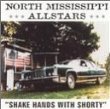Alan Paul's Blog, page 41
October 9, 2013
I really like the North Mississippi All Stars
I am just finishing up a feature on the North Mississippi All Stars for Relix. I love the band and I love Luther and Cody Dickinson as people. I spent a fair amount of time hanging with Luther last June at Butch Trucks’ Roots Rock Revival and it was a pleasure.
Going through my archives, I found this review of their 200 debut Shake Hands With Shorty that I wrote for the Washington Post. As you can see, I’ve been rather enthusiastic about them from the start.
The North Mississippi All Stars
Over the last decade, as ever more original practitioners have passed away, contemporary blues has become increasingly calcified and robbed of its essential spontaneity by two diametrically opposed forces. Purists intent on recreating the postwar Chicago music of Muddy Waters and Howlin’ Wolf have locked the blues into a museum, while Stevie Ray Vaughannabe’s have emphasized histrionics and virtuosity to the exclusion of almost everything else sacred to the music.
 In that context, Shake Hands With Shorty, the North Mississippi All Stars’ debut album, is remarkably fresh, invigorating and fun. From the first incendiary notes of “Shake Em Down” it’s clear that something quite unique is going down. Though drummer Cody Dickinson’s hip-hop influenced beats are distinctly modern, brother Luther Dickinson’s slide guitar and distorted vocals slice through with deep blues feeling. The song is off and rolling like a runaway train, and the band never really looks back; the entire album maintains this easy dichotomy between the old and new.
In that context, Shake Hands With Shorty, the North Mississippi All Stars’ debut album, is remarkably fresh, invigorating and fun. From the first incendiary notes of “Shake Em Down” it’s clear that something quite unique is going down. Though drummer Cody Dickinson’s hip-hop influenced beats are distinctly modern, brother Luther Dickinson’s slide guitar and distorted vocals slice through with deep blues feeling. The song is off and rolling like a runaway train, and the band never really looks back; the entire album maintains this easy dichotomy between the old and new.
It’s no great insult to say that the rest of Shake Hands can’t quite match the manic brilliance of its opening track, because little in roots rock has over the past decade. While they may never again reach such an ecstatic peak, the band’s energy and originality never flag. They attack every song with a joyous recklessness, reconfiguring in their own image the tunes of semi-obscure Mississippi blues greats Fred McDowell, R.L. Burnside, Furry Lewis and Junior Kimbrough.
It takes a rare and welcome combination of reverence and irreverence to lovingly record an entire album of such material while also including samples, Van Halen-style speed guitar runs and direct quotes of the Allman Brothers and Grateful Dead. It is the type of radical, iconoclastic restructuring of the blues which urban hipsters like Jon Spencer have imagined for years but never quite pulled off.
All Stars Cody and Luther Dickinson come by their eclecticism naturally. Their father is Jim Dickinson, a renegade Memphis musician best known for playing piano on the Rolling Stones’ “Wild Horses,” working extensively with Ry Cooder and producing albums by Big Star and the Replacements, amongst others. Thanks to him, they grew up both steeped in the droning, modal blues of their North Mississippi home base, and blessed with a broad and deep knowledge of the larger musical world. The Dickinson boys have wide-ranging musical resumes. Their endeavors include playing for years in the hardcore band DDT; touring in an acoustic jug band; playing with and producing 92-year-old fife and drum master Othar Turner; recording as teenagers with the Replacements; and serving as the backing band for fusion guitarist Shawn Lane.
On Shake Hands With Shorty, they bring all that diverse experience together in one combustible package. With the help of bassist Chris Chew and augmented by a cast that includes their father, Turner, Alvin Youngblood Hart, Lucinda Williams’ bassist Richard Price and R.L. Burnside’s sons Cedric and Gary, the Dickinson boys have created an off-the-cuff masterpiece. It’s a joyous, fun-loving album that does nothing less than breathe life back into a hallowed but moribund musical tradition.
*
New Rollin’ and Tumblin’ video from their latest album, World Boogie Is Coming, which highlights NMAS’ mix of old and new schools:
October 8, 2013
Howard Stern interviews Graham Nash and digs deep
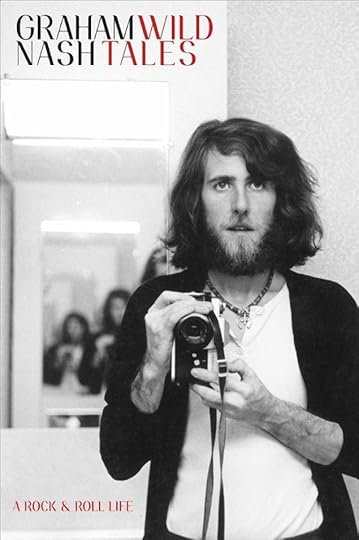 I’m not the biggest fan of Howard Stern and have never spent hours listening to him. I find a lot of his schtick juvenile and just not funny. But, man, when he’s engaged, he’s a great, great interviewer. Having essentially unlimited time allows conversations to unwind in a relaxed manner and to ramble down unexpected avenues.
I’m not the biggest fan of Howard Stern and have never spent hours listening to him. I find a lot of his schtick juvenile and just not funny. But, man, when he’s engaged, he’s a great, great interviewer. Having essentially unlimited time allows conversations to unwind in a relaxed manner and to ramble down unexpected avenues.
This interview with Graham Nash is fantastic. He is promoting his new memoir, Wild Tales: A Rock & Roll Life, and this interview makes me wants to buy and read. Really fascinating stuff. Nash is unusually clear-headed, insightful and seemingly honest.
October 3, 2013
The Making of Texas Flood
 In honor of Stevie Ray Vaughan’s birthday, the 30th anniversary of his debut recording and the release of a new version, Texas Flood (30th Anniversary Collection), I present the following story of the making of Texas Flood. This was written for and originally published in Mojo circa 2001.
In honor of Stevie Ray Vaughan’s birthday, the 30th anniversary of his debut recording and the release of a new version, Texas Flood (30th Anniversary Collection), I present the following story of the making of Texas Flood. This was written for and originally published in Mojo circa 2001.
When Stevie Ray Vaughan and Double Trouble were booked to play the 1982 Montreux Jazz Festival, it seemed that years of gigging and hard work had paid off. At last, the Texans who had spent years touring in a milk truck that leaked oil had gotten their break, becoming the first unsigned act to play the prestigious fest. It was a long way from the small clubs the trio played back home in Austin.
The booking came about thanks to the intervention of music industry big wig Jerry Wexler, who saw Vaughan and DT perform at a record release party for their former bandmate, singer Lou Ann Barton, and pledged to help. True to his word, Wexler had called his friend Claude Nobs, the Montreux promoter and helped secure them a slot. Vaughan and Double Trouble appeared on July 17, 1982, at the Montreux Casino amidst an evening of acoustic blues and the audience was less than impressed with their fiery, rocked-up show. Vaughan opened with Freddie King’s instrumental “Hide Away” and tore thorough staples-to-be like “Pride and Joy, “Texas Flood” and “Dirty Pool.”
Any blues fan today would give their eye’s tooth to witness this show. But the Montreux crowd, not expecting such a blistering assault on their evening and perhaps put off by Vaughan’s unabashed swagger and the simple fact that he was white, was les than enthusiastic. In fact, a good portion of the people present booed while the rest were oddly silent. The show can be seen in its entirety on the two-DVD set, Live At Montreux, 1982 & 1985 (which also includes the band’s triumphant return three years later, as superstars). Watching it now, it is impossible to fathom what the audience was thinking in their tepid-at-best reaction. It is not, however, hard to imagine the crushing disappointment Vaughan must have felt.
“Stevie was broken-hearted,” recalls bassist Tommy Shannon. “He turned around and said, ‘I don’t think we sounded that bad.’”
Adds drummer Chris Layton, “After the show we felt depressed and bewildered. We had come so far with such high expectations and the response was so bad.”
 Photographer Darryl Pitt recalls rushing backstage to console Vaughan, only to find him slumped on a small road case, looking like he had “been hit by a sledgehammer.” The dejection did not last long, however. The band was sitting glumly around its tiny dressing room when a Festival employee stopped by and said that David Bowie was in the house and wanted to meet them all.
Photographer Darryl Pitt recalls rushing backstage to console Vaughan, only to find him slumped on a small road case, looking like he had “been hit by a sledgehammer.” The dejection did not last long, however. The band was sitting glumly around its tiny dressing room when a Festival employee stopped by and said that David Bowie was in the house and wanted to meet them all.
“We sort of went, ‘David Bowie who?’” recalls Layton with a laugh. “And the guy said, ‘You know, David Bowie.’”
Vaughan, Layton and Shannon headed for the Musician’s Bar downstairs, where they hung out and chatted with Bowie for hours. Vaughan was, of course, delighted with the attentions of Bowie, who would soon proclaim the Texan the best urban blues player he’d ever heard and proclaim that no guitar player had juiced him up so much since he saw Jeff Beck in the early 60s at a London club. But Bowie, too, was pleased that the guitar firebrand was paying so much attention to him. On the heels of Low, Heroes and Scary Monsters, Bowie was regarded as a rather fringe artist in America at the time. So it was that when the rock star asked the unknown guitar stud whether he would be interested in doing some recording, the singer was just as pleasantly surprised that the guitarist said yes as the guitarist was that the offer was made.
“I expected and would have understood a polite ‘Thanks but no thanks,’” Bowie writes in the liner notes for the Montreux DVD. “You can’t imagine how delighted I was when he accepted the offer on the spot and said he’d love to try out a new kind of record just for the experience.”
The following night, Vaughan and company were booked to play the same hotel bar. Jackson Browne, who had performed at the Fest earlier that night was doing an interview in his hotel room when several members of his band barged in bubbling with excitement, insisting that whatever Browne was doing, he had to stop it and get down to the bar right now. Following his bandmates downstairs, Browne was similarly awed by what he witnessed and soon climbed on stage.
Recalls Layton. “We played all night, with Jackson and his whole band sitting in. We jammed until seven a.m., and at the end of the night Jackson said that he had a studio in L.A. and we were welcome any time we wanted to come record some tracks free of charge.”
Over the next six months, the meetings with Browne and Bowie would launch the career of Vaughan and Double Trouble and change the course of blues guitar, bu that was far from clear when the band returned to Austin. They were poorer than a church mouse and their immediate prospects didn’t seem any more promising than they had for the past few years. Vaughan decided to take Browne up on his offer. The singer agreed to give the group 72 hours in Down Town over Thanksgiving weekend, 198, and they quickly booked a short tour to help cover their travel expenses. While most of the studio staff wanted nothing to do with helping some raggedy assed unknowns over a long holiday weekend, engineer Greg Ladanyi offered his services.
“We went in there, just hoping hoped that maybe we were making a demo that would actually be listened to by a real record company,” says Layton.
They were, in fact, recording their debut album, Texas Flood, though the circumstances hewed much more closely to their demo ideas.
“Down Town really was just a big warehouse with concrete floors and some rugs thrown down,” says Shannon. “We found a little corner, set up in a circle looking at and listening to each other and played like a live band.”
“We just rolled in there like it was a rehearsal or something and the guys working there were mildly annoyed because it was Thanksgiving weekend and they wanted to be home,” says Layton. “We were so unprepared, we were like, ‘Hey, uh, you guys got any tape?’”
Ladanyi offered up some used tape to record over, including some of the demos for Browne’s not-yet-released album Lawyers in Love. The trio basically just ran through a typical live set of their strongest tunes. Ladanyi was not interested in getting too deeply involved and the band was unsatisfied with their sound throughout the first day. Richard Mullen, a Texas musician and friend of the band who had been coming to their shows and running sound gratis, happened to be in town, recording with singer Christopher Cross. Not wanting to ruffle any feathers and grateful for the free time, Vaughan had not pushed when Browne and Ladanyi balked at having an outsider behind the console, but by the time they broke for dinner on the first night, the guitarist was vocally upset with his mates about the results. Mullen replied by urging the shy frontman to exert his will, saying in essence, “This is your shot and your show and if you want anything to be different, you have to speak up.”
Returning to the studio newly emboldened, they found that Ladanyi had left. In his place was an assistant, who did not think his job involved more than “pushing the stop and record and buttons.” So Mullen took over, tuned the drums and dialed up the sounds he wanted to hear on Vaughan and Shannon’s amps. He also employed some sound baffles between the players to decrease leakage and allow cleaner tracks of each instrument without forcing the band to physically separate and lose their live vibe. From then on, the band rolled through their repertoire, recording two songs that night and eight the following day. There is some dispute about whether Mullen appeared at the end of the first day or the beginning of the second and whether the whole session lasted two or three days. In any case, they definitely did record seven of the album’s eventual 10 tracks on a single day, November 24, 1982, when they also cut “Tin Pan Alley,” a blues classic that was an SRV standard and which appears on Sony’s 1999 remastered version of Texas Flood. Vaughan cut only scratch vocals, adding only these tracks back at Mullen’s Austin studio.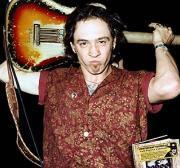
“That whole recording was just so pure; the whole experience couldn’t have been more innocent or naïve,” says Layton. “We were just playing. If we had known what was going to happen with it all, we might have screwed up. But we just went in there and did our live show. The magic was there and it came through on the tape.
“It’s funny, too, because people tell me all the time how much they love Stevie’s tone on that album and ask how he got it. It was so simple it’s ridiculous; he plugged his Strat into ‘Mother Dumble,’ a Dumble amp that Jackson owned and we found in the studio.”
THE ORIGINAL “TEXAS FLOOD” BY LARRY DAVIS:
Vaughan’s hard-edged, vintage sound would soon turn the guitar world’s perception of tone on its head. At the time, rock music seemed eager to leave the past behind. Indeed, many thought guitars passé, with futurists proclaiming that the instrument would be permanently transformed by MIDI applications and replaced as rock’s dominant instrument by the synthesizer. Even many guitar loyalists thought the classic sounds were no longer adequate, transforming their instruments by running them through racks of elaborate, high-tech gear to create heavily processed sounds. Odd-shaped, brightly colored axes were all the rage.
Vaughan’s gear throughout his career was profoundly old school and never more so than on Texas Flood. Eventually, the tones he coaxed from his old but timeless gear would ignite a vintage craze that rages to this day and also launch a new market for small, high-end boutique amplifiers that replicated classic sounds with modern conveniences.
Following the recording sessions, the group stayed in LA to play several dates. On one of these nights, Layton was awakened at the Oakland Gardens Hotel by a three am phone call. “I answered in a fog and it was a guy with an English accent asking for Stevie,” Layton recalls. “I said that he was sleeping and asked who was calling. He goes, ‘It’s David Bowie and I’d like to speak to him now if possible. I got Stevie up and Bowie asked him if he wanted to come to New York and cut some tracks.”
Vaughan accepted the offer and flew to New York in the third week of December to join Bowie and producer Nile Rodgers at the Power Studio. Let’s Dance was complete except for lead guitar tracks. Vaughan’s performances, Bowie has said, “ripped up everything everyone thought about dance records.” Vaughan had casually become the linchpin in birthing a sound that Bowie had long heard in his head – a new kind of dance music that combined Euro sensibility with raw American blues power. Blown away, Bowie quickly asked Vaughan to join his touring band and the offer was accepted, though not without some real angst about leaving behind his own group.
“Stevie‘s plan was to do it for a year, take the money and pay us to keep the band together,” Shannon says.
As rehearsals continued in Dallas, then New York, Bowie and his band grew increasingly excited about the sound they were crafting around Vaughan’s blistering lead work and anticipation rose for bringing this heady brew around the world.. It was not to be, however.
What happened next is not entirely clear. Bowie says that as the band was literally loading onto a bus to go to the airport and fly to Europe and commence touring, Vaughan’s manager demanded a much higher salary or else the guitarist would not tour. The offer was promptly rejected, leaving the guitarist and his bags stranded on the sidewalk as the bus pulled away without him. Layton and Shannon have different recollections of the event. They say that Vaughan, already uncomfortable in a sideman’s role and upset that several promises about opening some shows himself were broken, finally snapped when told that he couldn’t mention his own band or music in interviews.
“He just couldn’t do it because it wasn’t what he loved playing,” Shannon says. “He liked David and his music, but it wasn’t where he was headed and Stevie could not do what he didn’t love.”
Whatever the exact circumstances, Vaughan most definitely did quit Bowie on the eve of a huge world tour to return to Double Trouble and their oil-leaking milk truck.
“I really wasn’t surprised when Stevie quit, but I sure was happy,” recalls Layton. “I couldn’t believe that just when we seemed to have all this momentum, Stevie was going to be gone for at least a year, maybe more. We really thought it might be over, right when we had worked so hard to get to that point, where it seemed like something was going to happen.”
Something was, in fact, already happening. Urged on by Layton and Shannon, who were feeling increasingly desperate that their moment was passing, manager Chesley Millikin had been shopping the 10-song tape made at Browne’s studio and found an admirer in John Hammond. The septuagenarian A&R man, whose discoveries and signings included Billie Holliday, Bob Dylan and Bruce Springsteen, took the tapes to Epic and essentially demanded they sign him. Just like that, and with little other label interest, Vaughan quickly had a deal with Epic Records.
“Epic wanted to release our demo right away and we got more attention because people wanted to know who this unknown guy who told David Bowie to take a hike was,” says Layton.
Vaughan’s pungent playing on Let’s Dance, redolent of Albert King, garnered attention as well, from fans and fellow musicians alike.
“I was driving and ‘Let’s Dance’ came on the radio,” recalls Eric Clapton. “I stopped my car and said, ‘I have to know who this guitar player is today. Not tomorrow, but today.’ That has only happened to me three or four times ever, and probably not for anyone in between Duane Allman and Stevie.”
With Hammond on board as Executive Producer, Vaughan cut new vocals for “I’m Cryin’” before the album was mixed at New York’s Media Sound and released on June 13, 1983.
“We started touring behind Texas Flood and we could feel things changing, the crowds slowly getting bigger and bigger,” says Shannon. “Then we got rid of the milk truck and got a bus and we were in heaven — even though it was a really shitty bus.”
Adds Layton, “We toured the whole country, playing every night, selling out 500 seat clubs, with 200 people standing outside trying to get in. We could feel this incredible momentum building.”
“What really brought it all home for me was when we played at the Palace in Hollywood,” adds Shannon. “We had played there before to mediocre crowds and this time there was a line stretching down the street and around the corner.” (Three songs from the September 23, 1983, performance at the Palace are featured on the remastered Texas Flood.)
Proof that Vaughan was entering the music mainstream came when the album was nominated for two Grammys: Best Traditional Blues Recording and Best Rock Instrumental Performance (for “Rude Mood”). The band also appeared on the Austin City Limits television show and Vaughan won three categories in Guitar Player magazine’s Readers Poll: “Best New Talent”, “Best Blues Album”, and “Best Electric Blues Guitarist,” an award he would win every year until his death. MTV was still fairly new and quite wide open and they began playing the video for “Pride and Joy.” In retrospect, given the strength of the album, all this success seems obvious, but in 1983, it was anything but. A reasonable betting man would have wagered his house that Vaughan and his old school blues-rock trio would fail to register on the popular culture’s radar screen. But the 29-year-old guitar firebrand was clearly playing by his own set of rules. “He was a leader, not a follower,” notes B.B. King “and you didn’t have to be a guitar expert to know that.”
Texas Flood blew open the locked doors of popular music and proclaimed that blues could be a potent commercial force. The album, combined with the runaway success of Let’s Dance, not only put the unknown Texan on the map but also signaled that uncompromised, from-the-gut guitar music was not dead as a commercial and artistic force.
“Stevie Ray Vaughan single-handedly brought guitar- and blues-oriented music back to the marketplace,” recalls Dickey Betts, whose Allman Brothers Band were prominent casualties of the era’s anti-roots disease. “He was just so good and strong that he would not be denied. When I heard ‘Pride and Joy’ on the radio, I said ‘Hallelujah.’”
Vaughan’s dramatic arrival not only helped smooth the way for the return of classic blues-oriented rock acts like the Allman Brothers, but it also made the environment more hospitable for his own peers, including The Fabulous Thunderbirds (featuring big brother Jimmie Vaughan), Robert Cray, and Los Lobos, all of whom had hits in the years following Texas Flood. Stevie also shone a bright spotlight back on his original heroes, most of whom had been languishing — overlooked and usually sans record deal. Albert King, Buddy Guy, Lonnie Mack, Hubert Sumlin, Otis Rush and Albert Collins suddenly found themselves once again being hailed as guitar titans, with interest in their music skyrocketing to levels unseen since the white rock audience’s initial discovery of blues in the 1960’s.
Certainly, as he himself pointed out, Vaughan owed a huge debt to these originators, but his music was not simply derivative; he hungrily swallowed his influences, fully digested them and crafted a style uniquely his own. In so doing, he succeeded where countless others had failed — reinventing the blues in a manner both visionary and true to the original material. It was a goal shared by every hippie with a Muddy Waters record but accomplished by precious few.
“Stevie’s playing just flowed,” says B.B. King. “He never had to stop to think. His execution was flawless, and his feel was impeccable. Stevie could play as fast as anyone, but he never lost that feel.”
Adds Bonnie Raitt, a longtime friend of Vaughan’s, “Just when you thought there wasn’t any other way to make this stuff your own, he came along and blew that theory to bits. Soul is an overused word, but the fire and passion with which he invested everything he touched was just astounding, as was the way in which he synthesized his influences and turned them into something so fiercely personal.”
The word about Vaughan was out on the blues circuit for years, Raitt adds. Guy, King, Dr. John and others who passed through Austin had long been telling her about this kid who “was just killing it.” With the release of Texas Flood, the rest of the world got hipped as well.
// ]]>
Amazon.com Widgets
September 30, 2013
Why I’m driving to Pittsburgh for a baseball game
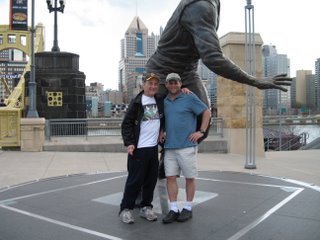
That crazy game in 2006.
Tomorrow morning, I will see my kids off to school, kiss Becky good bye, gas up my Chevrolet and drive 357 miles from my New Jersey home to see a baseball game in my hometown of Pittsburgh. It was not a difficult decision.
The NL Wildcard Playoff game against the Cincinnati Reds is an opportunity to square some circles – with my abiding love for my hometown, whose proud Diaspora I have lived amongst since I was 18; with the Pirates, my favorite childhood team and original sports obsession, who just this year broke a 20-year losing streak, the longest such run not just in baseball but in any North American team sport; and with the man who fueled my love for the Pirates and as a kid and stuck by them for two decades of losing: my father, Dixie Doc.
As with many men, sports were always an avenue of communication between my father, brother and I, a way to keep talking even through years when there were distances in other regards. Back in the days when I thought it was reasonable idea to drive a garbage truck from Ann Arbor to Tegucigalpa, Nicaragua to aid the struggling Sandinistas, when the pockets of my thrift store overcoat overflowed with things my father didn’t approve of; and I disregarded his advice about many things, including how far it was reasonable drive to have some fun. Even then, we had the Pirates.
Now we will go the stadium together to celebrate the team’s return to relevance, which I believe will be a magical moment for the city of Pittsburgh and the hardcore group of us who kept paying attention through so much atrocious baseball. There will never be the first game again.
The last time the Bucs were in contention was 1992; there was no internet to speak of. Dixie clipped articles form the Pittsburgh Post Gazette and sent them to me in Manhattan, where I lived, or wherever else I might be. In the intervening years, the Pirates have never been good and they have oftentimes been spectacularly bad. Even during those years, my father’s optimism would bloom in the spring, and we would go to games, eventually joined by my sons Jacob and Eli.
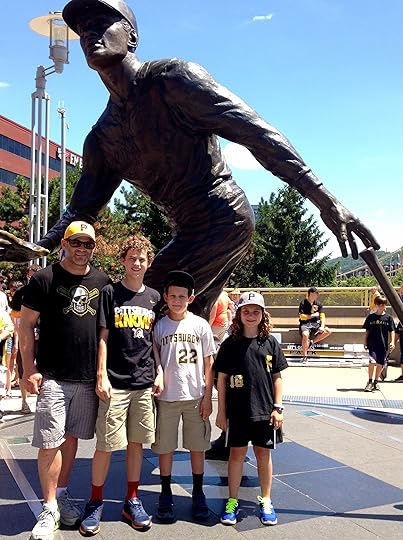 My boys, now 15 and 13, became diehard Steelers fans, a fun passion to share through a few Super Bowl runs, but I told them they didn’t have to come with me to the Pirates. Being a fan of the team has been a unique brand of torture. We live in Yankees land. Many of our friends are Red Sox fanatics. I always liked the Oakland A’s. I urged my kids to pick any baseball team they fancied. They stuck by the Bucs. They stuck by me. They stuck by my dad. Eventually, their sister Anna joined in as well, proudly wearing a pink Pirates hat.
My boys, now 15 and 13, became diehard Steelers fans, a fun passion to share through a few Super Bowl runs, but I told them they didn’t have to come with me to the Pirates. Being a fan of the team has been a unique brand of torture. We live in Yankees land. Many of our friends are Red Sox fanatics. I always liked the Oakland A’s. I urged my kids to pick any baseball team they fancied. They stuck by the Bucs. They stuck by me. They stuck by my dad. Eventually, their sister Anna joined in as well, proudly wearing a pink Pirates hat.
Eight years ago I had just moved to Beijing with my young family when my father called on a Sunday morning and told me he had bladder cancer. I recounted the difficulties and emotional complexities of dealing with an illness like this from 8,000 miles away in Big in China. About six months after that initial phone call, following months of chemotherapy, my father went under the knife and had his bladder removed and a new one created from his intestine. A couple of days later I flew from Beijing to New York to visit him, expecting to spend a week in the city, staying with my mother and visiting my father daily in the hospital. A day after I arrived, Dixie announced he was heading home. He checked himself out of the hospital, pronouncing it “a good place to die.” The next thing I knew I was back in Pittsburgh, sleeping in my childhood bed.
On day two, the Pirates were playing the Dodgers in a day game and Dixie suddenly said, “Hey let’s go down to the stadium and have pulled pork sandwich for lunch and watch the game for a while.”
So off we went. My mom drove us down and dropped us at the door so we didn’t have to walk anywhere; we bought some scalped box seats for 20 bucks and were sitting in the sun by the top of the 2nd. The Bucs lost 13-5 in a rather pathetic show but being there together was rather amazing. I’ve tried to retain that same level of appreciation for every special moment.
A few years later, I had a Big in China. reading in Pittsburgh that happened to be on the day of the Bucs’ home opener. My dad and I attended together. Since then, we’ve been back many times, often with my kids as well. My drive to Pittsburgh is to celebrate the resurrection of a team I love, but it’s about a lot more as well.
September 27, 2013
One Way Out: The Inside History of the Allman Brothers Band… Coming Soon!
One Way Out: The Inside History of the Allman Brothers Band
Over 400 pages. Interviews with over 50 people, including Gregg Allman, Dickey Betts, Butch Trucks, Jaimoe, Warren Haynes, Allen Woody, Eric Clapton, Tom Dowd, Phil Walden, Red Dog and many, many others…
32 Pages of glossy photos, plus many more in text. 150 photos total, by Danny Clinch, Stephen Paley, Jim Marshall, Sidney Smith, Neal Preston, Kirk West, Twiggs Lyndon and others.
Foreword by Butch Trucks. Afterword by Jaimoe.
“No one knows the ins and outs of the Allman Brothers Band better than Alan Paul.”
-Warren Haynes
Much more to come soon.
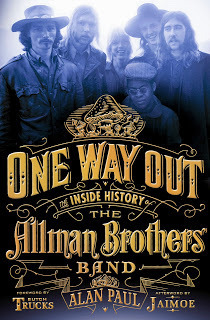
September 25, 2013
The story behind “Some Kind of Wonderful”
Bob Lefsetz wrote about the song “Some Kind of Wonderful,” made into a hit by Grand Funk Railroad, which prompted the song’s writer and original singer John Ellison, of the great, forgotten Soul Brothers Six, to respond. I found his story about how and why he wrote the song really great, and I love the original version of the song – which you can check out at the bottom of this post.
From: “W.J. Ellison”
Subject: Fwd: SHE’S SOME KIND OF WONDERFUL
Hi Bob,
Thanks for writing the article.
I would like to share a story with you, and fans, of how the phrase some kind of wonderful, came to be a song. I still remember that moment as if it was yesterday. My band, the Soul Brothers Six, had signed a recording contract with a small independent record label in Philadelphia that was owned by Walter Rayfield. We met Walter at a club in Rochester, New York where we played every weekend. He convinced us to sign a management contract, plus a recording contract with him, and invited our group to come to Philly to record.
The day we were leaving for Philadelphia, I stopped by the apartment of the girl I was dating, to say goodby. Her name was Ann White. She had packed me a lunch in a brown paper bag. We stood there in silence for a moment just looking at each other. I knew this was the last time I would see her, I knew she wanted more from me than I could give her, but she understood. She knew I had dreams that nothing could get in the way of. I gave her a hug, and we kissed. I looked at her and said, you are some kind of wonderful, I’m gonna write a song about you.
This was around 6am, I turned and walked towards the old 1960 Ford we had bought for the trip that was eaten up by rust. You could see the highway through the rusted out holes in the floor. After about four hours into the trip, I ate the sandwich Ann had prepared for me. After I finished the sandwich, I began writing the lyrics to some kind of wonderful on the bag she had packed my lunch in.
I don’t need a whole lots of money, I don’t need a big fine car, I’ve got everything that a man could want, I’ve got more, than I could ask for.
This is the reason for those first three lines. The first line was because at that moment, money could not make me feel the way I was feeling. Although I did not want a relationship with Ann, I did have feelings for her. This was something that money could not buy.
Regarding the big fine car, I knew I could be just as happy with her in the old rusted out Ford,as I would be in a brand new car because I would have everything that I could hope for. That’s how she made me feel.
Some Kind Of Wonderful was written in less than a half hour, which included the melody, the arrangement of all the music, which included the famous bass line that have been featured in many songs over the years and as the saying goes, the rest is history.
Because of the many turn of events that have happened in my life, I have
written my autobiography. The Soul Brother’s Six have a story that need to be told also. I am sure that one day, our story will be made into a movie.
Best regards,
John Ellison
// ]]>
Amazon.com Widgets
September 23, 2013
Dickey Betts joins Tedeschi Trucks Band on stage at the Beacon
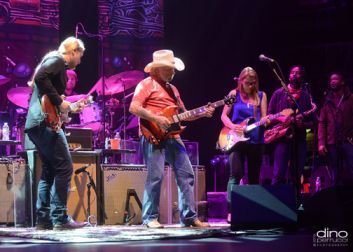
Photo by Dino Perucci
Dickey Betts joined Derek Trucks and the Tedeschi Trucks Band onstage at the Beacon Theatre Saturday night, September 21 for three songs: “Blue Sky,” “In Memory of Elizabeth Reed,” and “The Sky Is Crying.” Dickey’s son and bandmate Duane was also on stage for the latter. I knew this was coming and would have very much loved to be there but alas it happened on the night of my son’s bar mitzvah – and even I’m not that crazy.
As the chronicler of all things Allmans, I’ve already been asked by many what I think and what this all means. I think it’s great and I have no idea what it means, nor does anyone else. The only thing it means for sure is that Dickey Betts once again played some of his most beloved tunes on stage to a packed and appreciative Beacon crowd with Derek Trucks. That’s pretty cool in and of itself. I was not shocked by this, because Derek has always told me and he says in One Way Out: The Inside History of the Allman Brothers Band that Dickey was always very kind to him, and you can see the videos of Derek jamming with the ABB when he was 13 and Dickey being very solicitous and calling him a “bad little scooter.”
Derek introduced Dickey as “my father’s favorite guitar player.”
How was the music? Judge for yourself – videos below. “Blue Sky” sounds the best to me, but use your own eyes and ears.
“Blue Sky”:
“In Memory of Elizabeth Reed”:
“The Sky Is Crying” (with Duane Betts also):
// ]]>
Amazon.com Widgets
September 17, 2013
New Warren Haynes interview
My latest interview with Warren Haynes is out in the latest Guitar World… November 2013 issue, on sale now… Go buy it! We discuss Gov’t Mule’s new album Shout! and the symphonic Jerry Garcia tour.
A tiny sample:
GW: It’s been four years since the last Gov’t Mule album. There’s a lot of water under the Warren bridge since then. Do you think that all factored into this album sounding quite different from anything you’ve done?
HAYNES: A lot of factors played into the final result. We allowed ourselves to take a hiatus and that year off helped us gain some perspective, look back on everything we’ve done and figure out what kind of record we wanted to make. This is our most diverse record and I don’t think we could have done it 10 years ago. Each song we brought to the table had it its own personality; it sounded like Gov’t Mule but didn’t sound like anything we had ever done, which helped the overall flow and keeping the process moving forward.
Next year we are celebrating our twentieth anniversary so I think it’s appropriate to shine a light on as many influences as possible and how much we’ve grown over the years. It took this long to have a license to release something this diverse.
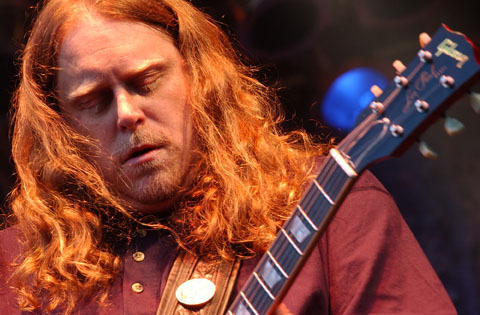
August 22, 2013
Try a new Chinese cuisine
•Try a kind of Chinese cuisine you’ve never heard of before.
China is a vast nation, with over 30 distinctly different provincial regions, each with its own array of distinct cuisines. Yet in America, Chinese food has generally been reduced to gone-native versions of Hunan, Sichuan and Cantonese foods. While all of these areas certainly have their delights, there are countless other excellent Chinese cuisines just begging to be tried, all of them readily available in Beijing.
1. Guizhou
Guizhou food is spicy but not overpowering, with more subtlety and contrasting textures and flavors than its better-known cousin, Sichuan food. In Guizhou, they balance the fiery peppers with sour pickles, mint and other fresh herbs. Sour soup fish is one specialty not to be missed and the spicy ribs readily found in most Guizhou restaurants are slow cooked until they melt off the bone. A wide range of great noodle dishes is also worth sampling
TRY: Three Guizhou Men, Private Kitchen No. 44
Three Guizhou Men
Private Kitchen No. 44
2. Hot Pot
The concept is simple enough: take a boiling pot of broth, filled with huge chunks of garlic, ginger, ginseng and God-knows-what-else and drop in thin-sliced pieces of your favorite meat, vegetables, tofu and anything else you can think of. Dip it into a sesame sauce, eat, and smile.
Hot pot is a really fun, delicious, uniquely Chinese meal. It comes in many varieties, most famously Sichuan (hot broth) and Mongolian (highly flavored but not super spicy broth). Hot pot is Chinese comfort food, particularly popular in the winter. As such there are many little joints serving the dish, but there are also a number of newer, more contemporary hot pot places. Some also offer individual hot pots.
TRY: Ding Ding Xiang, Little Sheep
Ding ding Xiang
Little Sheep
3. Yunnan
Yunnan is a province in China’s Southwest, home to rainforest jungle in its South and soaring Himalayan Mountains in the Northwest, where it borders Tibet and has large ethnically Tibetan regions. The food represents this diverse, interesting range. Pineapple and lemongrass appear often, and the area is also famous for its ham and mushrooms.
TRY: South Silk Road, Golden Peacock
South Silk Road —
Golden Peacock
4. Xinjiang
Xinjiang is a Muslim-dominated “autonomous region” in far Western China, bordering Kazakhstan, Afghanistan and Pakistan. The food reflects this Central Asian heritage, with lots of delicious grilled lamb and fresh-baked flat bread amongst other savory treats, with a Chinese influence that makes it distinctly its own. Fresh noodles are also popular and it you’re in a large group and you’re not too squeamish, call ahead to see if you can order a whole roast lamb.
Beijing has many fine Xinjiang restaurants from high end to tiny neighborhood kebab joints. Some, including the recommended Red Rose also include raucous belly dancing and musical shows.
TRY: The Red Rose, Crescent Moon Muslim Restaurant
The Red Rose
Crescent Moon
5. Vegetarian
This may seem like an odd choice, but there is a Chinese vegetarian tradition, stemming from Buddhist temples, of faux meat dishes prepared with flair and imagination. At the recommended place, you will sample some of the best “duck,” “chicken” and “beef” you’ve ever had. You’ll have to try it to believe it.
TRY: Bodhi Sake, located in a converted Buddhist temple, Pure Lotus
August 21, 2013
World blues: guqin/guitar duet
This was a fully improvised performance at the Xiamen Beach Festival discussed in the Big in China prologue. Zhang Yong opened up with a solo guqin piece and 10 minutes before he went on, e told me to come out when he looked at me and nodded and “just play these chords,” which he showed me. Lu Wei came out and sat down at his drums to give it a little kick. Zhang Yong is a musical genius, and we were just starting to explore this type of real Chinese blues fusion. Never quite fully seeking out what might have happened is one of my great disappointments about leaving China earlier than planned.


